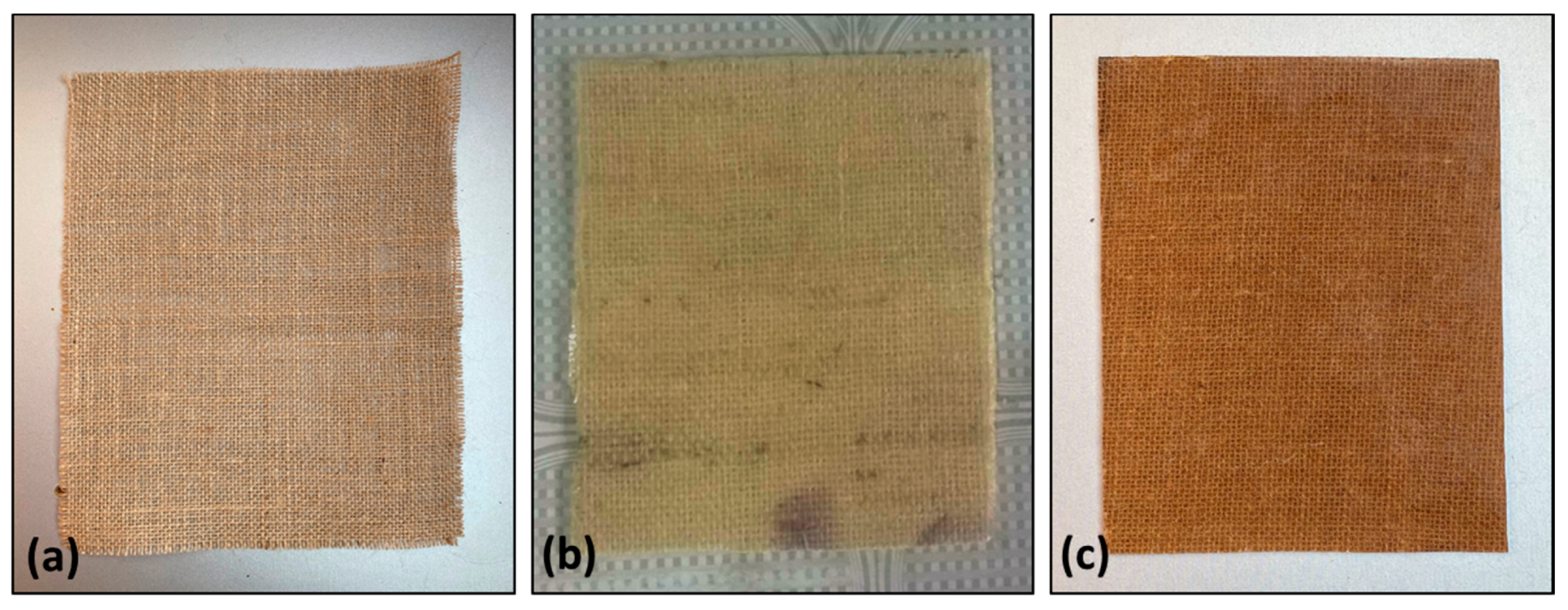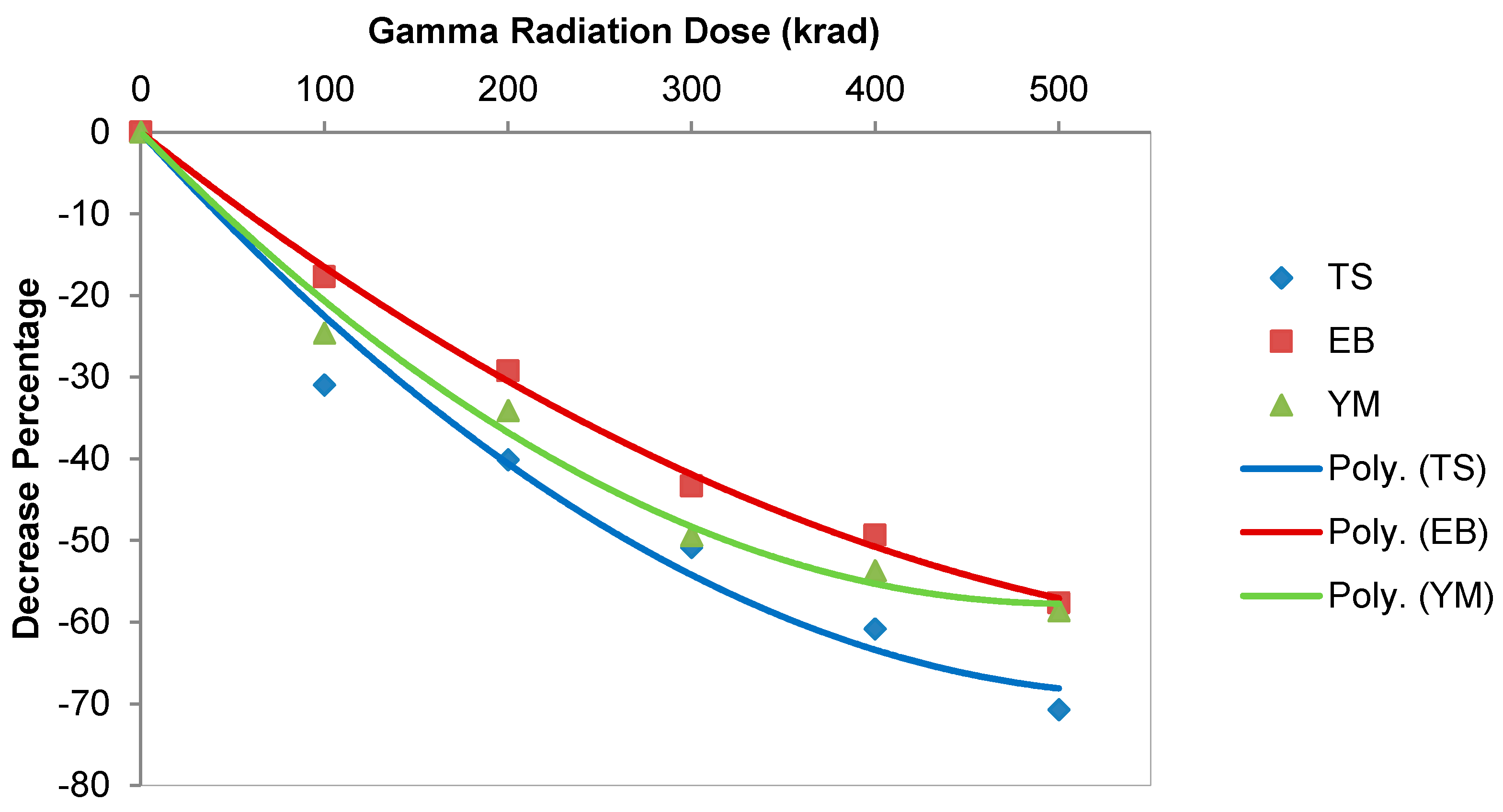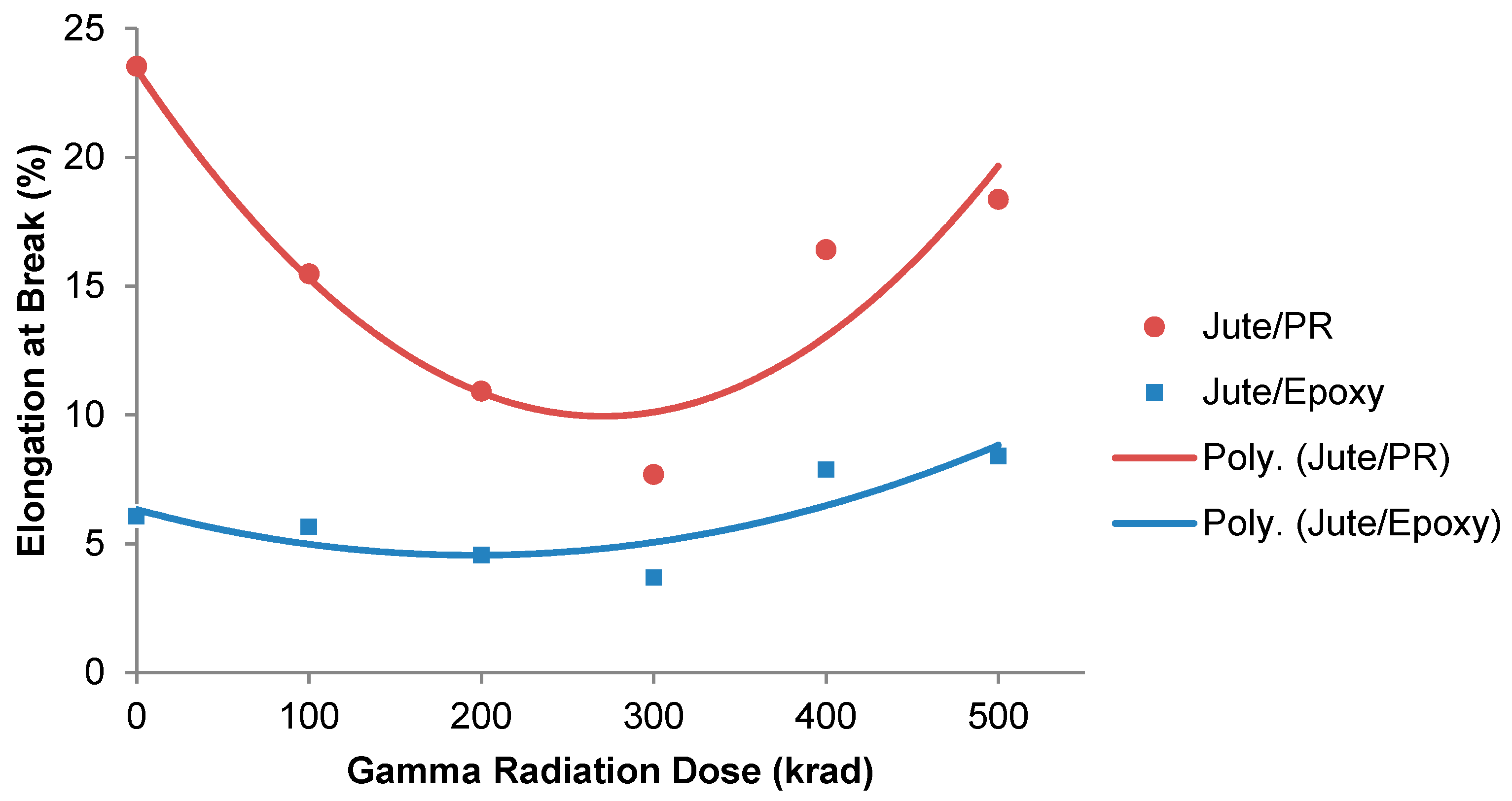Influence of Gamma Radiation on Mechanical Properties of Jute Fabric-Reinforced Polymer Composites
Abstract
:1. Introduction
2. Materials and Methods
2.1. Materials
2.2. Methods
2.2.1. Fabrication of Composite
2.2.2. Sampling
2.2.3. Gamma Radiation
2.2.4. Mechanical Properties
3. Results and Discussion
3.1. Mechanical Properties of Jute Fabrics
3.2. Tensile Strength (TS) of Jute Composites
3.3. Elongation at Break (Eb%) of Jute Composites
3.4. Young’s Modulus (Y) of Jute Composites
4. Conclusions
Author Contributions
Funding
Conflicts of Interest
References
- Mohammed, L.; Ansari, M.N.M.; Pua, G.; Jawaid, M.; Islam, M.S. A review on natural fiber reinforced polymer composite and its applications. Int. J. Polym. Sci. 2015, 2015. [Google Scholar] [CrossRef] [Green Version]
- Ates, B.; Koytepe, S.; Ulu, A.; Gurses, C.; Thakur, V.K. Chemistry, structures, and advanced applications of nanocomposites from biorenewable resources. Chem. Rev. 2020, 9304–9362. [Google Scholar] [CrossRef] [PubMed]
- Sanjay, M.R.; Arpitha, G.R.; Naik, L.L.; Gopalakrishna, K.; Yogesha, B. Applications of natural fibers and its composites: An overview. Nat. Resour. 2016, 7, 108. [Google Scholar] [CrossRef] [Green Version]
- Singha, A.; Thakur, V.K. Synthesis and characterization of pine needles reinforced RF matrix based biocomposites. Eur. J. Chem. 2008, 5. [Google Scholar] [CrossRef]
- Saba, N.; Jawaid, M.; Alothman, O.A.; Paridah, M.T. A review on dynamic mechanical properties of natural fibre reinforced polymer composites. Constr. Build. Mater. 2016, 106, 149–159. [Google Scholar] [CrossRef]
- Singha, A.; Thakur, V.K. Mechanical, thermal and morphological properties of grewia optiva fiber/polymer matrix composites. Polym. Technol. Eng. 2009, 48, 201–208. [Google Scholar] [CrossRef]
- Ameer, M.H.; Nawab, Y.; Ali, Z.; Imad, A.; Ahmad, S. Development and characterization of jute/polypropylene composite by using comingled nonwoven structures. J. Text. Inst. 2019, 1–8. [Google Scholar] [CrossRef]
- Xiao, Z.; Pei, L.; Zhang, F.; Sun, Y.; Geng, L.; Wu, J.; Tong, J. Parameter Measurement of Biaxial Braided Composite Preform Based on Phase Congruency. Autex Res. J. 2019, 19, 8–16. [Google Scholar] [CrossRef] [Green Version]
- Ashir, M.; Nocke, A.; Cherif, C. Effect of the Position of Defined Local Defect on the Mechanical Performance of Carbon-Fiber-Reinforced Plastics. Autex Res. J. 2019, 19, 74–79. [Google Scholar] [CrossRef] [Green Version]
- Wahab, N.; Srinophakun, P.; Hussain, Q.; Chaimahawan, P. Performance of Concrete Confined with a Jute–Polyester Hybrid Fiber Reinforced Polymer Composite: A Novel Strengthening Technique. Fibers 2019, 7, 72. [Google Scholar] [CrossRef] [Green Version]
- Singha, A.; Thakur, V.K. Fabrication and characterization of H. sabdariffa fiber-reinforced green polymer composites. Polym. Plast. Technol. Eng. 2009, 48, 482–487. [Google Scholar] [CrossRef]
- Tripathi, P.; Gupta, V.K.; Dixit, A.; Misra, R.K. Development and characterization of low cost jute, bagasse and glass fiber reinforced advanced hybrid epoxy composites. AIMS Mater. Sci. 2018, 5, 320–337. [Google Scholar] [CrossRef]
- Rahman, R.; Huque, M.; Islam, N.; Hasan, M. Improvement of physico-mechanical properties of jute fiber reinforced polypropylene composites by post-treatment. Compos. Part A Appl. Sci. Manuf. 2008, 39, 1739–1747. [Google Scholar] [CrossRef]
- Das, S. Mechanical properties of waste paper/jute fabric reinforced polyester resin matrix hybrid composites. Carbohydr. Polym. 2017, 172, 60–67. [Google Scholar] [CrossRef]
- Ashraf, M.A.; Zwawi, M.; Mehran, M.T.; Kanthasamy, S.; Bahadar, A. Jute based bio and hybrid composites and their applications. Fibers 2019, 7, 77. [Google Scholar] [CrossRef] [Green Version]
- Mohanty, A.; Khan, M.; Hinrichsen, G. Influence of chemical surface modification on the properties of biodegradable jute fabrics—Polyester amide composites. Compos. Part A Appl. Sci. Manuf. 2000, 31, 143–150. [Google Scholar] [CrossRef]
- Gowda, T.M.; Naidu, A.; Chhaya, R. Some mechanical properties of untreated jute fabric-reinforced polyester composites. Compos. Part A Appl. Sci. Manuf. 1999, 30, 277–284. [Google Scholar] [CrossRef]
- Ahmed, K.S.; Vijayarangan, S. Tensile, flexural and interlaminar shear properties of woven jute and jute-glass fabric reinforced polyester composites. J. Mater. Process. Technol. 2008, 207, 330–335. [Google Scholar] [CrossRef]
- Ahmed, K.S.; Vijayarangan, S.; Naidu, A. Elastic properties, notched strength and fracture criterion in untreated woven jute–Glass fabric reinforced polyester hybrid composites. Mater. Des. 2007, 28, 2287–2294. [Google Scholar] [CrossRef]
- Vo, D.M.P.; Hoffmann, G.; Cherif, C. Novel weaving technology for the manufacture of 2D net shape fabrics for cost effective textile reinforced composites. Autex Res. J. 2018, 18, 251–257. [Google Scholar] [CrossRef] [Green Version]
- Mitra, B.; Basak, R.; Sarkar, M. Studies on jute-reinforced composites, its limitations, and some solutions through chemical modifications of fibers. J. Appl. Polym. Sci. 1998, 67, 1093–1100. [Google Scholar] [CrossRef]
- Das, S.; Singha, A.K.; Chaudhuri, A.; Ganguly, P.K. Lengthwise jute fibre properties variation and its effect on jute—Polyester composite. J. Text. Inst. 2019, 1–8. [Google Scholar] [CrossRef]
- Jafaria, R. Effect of Gamma and electron beam irradiation on PAN-carbon fiber composite. Braz. J. Radiat. Sci. 2016, 4, 1–11. [Google Scholar] [CrossRef]
- Khan, M.A.; Khan, R.A.; Haydaruzzaman; Hossain, A.; Khan, A.H. Effect of gamma radiation on the physico-mechanical and electrical properties of jute fiber-reinforced polypropylene composites. J. Reinf. Plast. Compos. 2009, 28, 1651–1660. [Google Scholar] [CrossRef]
- Shubhra, Q.T.; Alam, A. Effect of gamma radiation on the mechanical properties of natural silk fiber and synthetic E-glass fiber reinforced polypropylene composites: A comparative study. Radiat. Phys. Chem. 2011, 80, 1228–1232. [Google Scholar] [CrossRef]
- Khan, M.A.; Khan, R.A.; Haydaruzzaman; Ghoshal, S.; Siddiky, M.N.A.; Saha, M. Study on the physico-mechanical properties of starch-treated jute yarn-reinforced polypropylene composites: Effect of gamma radiation. Polym. Plast. Technol. Eng. 2009, 48, 542–548. [Google Scholar] [CrossRef]
- Haydaruzzaman; Khan, R.A.; Khan, M.A.; Khan, A.H.; Hossain, M.A. Effect of gamma radiation on the performance of jute fabrics-reinforced polypropylene composites. Radiat. Phys. Chem. 2009, 78, 986–993. [Google Scholar] [CrossRef]
- Hoque, M.A.; Bhuiya, A.K.; Saiduzzaman; Islam, A.; Khan, M.A. Effect of γ (gamma)-radiation on mechanical properties of raw and polyethylene glycol-modified bleached jute reinforced polyester composite. World J. Eng. 2017, 14, 108–113. [Google Scholar] [CrossRef]
- Wan, Y.Z.; Wang, Y.L.; Luo, H.L.; Chen, G.C.; Yuan, C.D. Effect of surface treatment of carbon fibers with gamma-ray radiation on mechanical performance of their composites. J. Mater. Sci. 2005, 40, 3355–3359. [Google Scholar] [CrossRef]
- Vasco, M.C.; Neto, S.C.; Nascimento, E.M.; Azevedo, E. Gamma radiation effect on sisal/polyurethane composites without coupling agents. Polímeros 2017, 27, 165–170. [Google Scholar] [CrossRef]
- Patra, S.; Mohanta, K.L.; Parida, C. Mechanical Analysis of Bio-Composites Using Gamma Irradiated Fibers of Luffa Cylindrica. In International Conference on Intelligent Computing and Communication Technologies; Springer: Berlin/Heidelberg, Germany, 2019. [Google Scholar]
- Amir, S.M.; Suilan, M.T.B.H.; Jawaid, M.; Safri, S.N.A. Effects of layering sequence and gamma radiation on mechanical properties and morphology of Kevlar/oil palm EFB/epoxy hybrid composites. J. Mater. Res. Technol. 2019, 8. [Google Scholar] [CrossRef]
- Das, S.C.; Paui, D.; Islam, J.M.M.; Khan, M.A. Effect of gamma radiation on the mechanical properties of PET felt reinforced polyester composites. In Proceedings of the International Conference on Mechanical, Industrial and Energy Engineering, Khulna, Bangladesh, 26–27 December 2016. [Google Scholar]
- Shauddin, S.M.; Shaha, C.K.; Khan, M. Effects of fiber inclusion and γ radiation on physico-mechanical properties of jute caddies reinforced waste polyethylene composite. J. Polym. Biopolym. Phys. Chem. 2014, 2, 91–97. [Google Scholar]
- Ndiaye, D.; Badji, A.M.; Tidjani, A. Physical changes associated with gamma doses on wood/polypropylene composites. J. Compos. Mater. 2014, 48, 3063–3071. [Google Scholar] [CrossRef]
- Xu, Z.; Huang, Y.; Zhang, C.; Liu, L.; Zhang, Y.; Wang, L. Effect of γ-ray irradiation grafting on the carbon fibers and interfacial adhesion of epoxy composites. Compos. Sci. Technol. 2007, 67, 3261–3270. [Google Scholar] [CrossRef]
- Martínez-Barrera, G.; Martínez-López, A.; Vigueras, E. Effects of Gamma Radiation on the Physicochemical Properties of Polyester Resin and Its Use in Composite Materials, in Recycled Polyester; Springer: Berlin/Heidelberg, Germany, 2020; pp. 15–28. [Google Scholar]
- Motaleb, K.A.; Islam, M.S.; Milašius, R. Effect of Gamma Radiation on the Mechanical Properties of Natural Fabric Reinforced Polyester Composites. Fibres Text. East. Eur. 2019, 27, 136. [Google Scholar] [CrossRef]
- Kafi, A.; Abedin, M.Z.; Beg, M.D.H.; Pickering, K.L.; Khan, M.A. Study on the mechanical properties of jute/glass fiber-reinforced unsaturated polyester hybrid composites: Effect of surface modification by ultraviolet radiation. J. Reinf. Plast. Compos. 2006, 25, 575–588. [Google Scholar] [CrossRef]
- Hossen, J. Evaluating the performance of gamma irradiated okra fiber reinforced polypropylene (PP) composites: Comparative study with jute/PP. Fash. Text. 2018, 5, 28. [Google Scholar]
- Supreet, R.; Vinod, B.; Sudev, L. Effect of gamma irradiation on mechanical properties of natural fibers reinforced hybrid composites. Inter. J. Sci. Technol. Eng. 2015, 2, 15–23. [Google Scholar]
- EL-Zayat, M.M.; Abdel-Hakim, A.; Mohamed, M.A. Effect of gamma radiation on the physico mechanical properties of recycled HDPE/modified sugarcane bagasse composite. J. Macromol. Sci. 2019, 56, 127–135. [Google Scholar] [CrossRef]
- Rahman, M.; Hoque, A.; Rahman, G.Y.; Azmi, M.M.; Gafur, M.A.; Khann, R.A.; Hossain, M.K. Fe2O3 nanoparticles dispersed unsaturated polyester resin based nanocomposites: Effect of gamma radiation on mechanical properties. Radiat. Eff. Defects Solids 2019, 174, 480–493. [Google Scholar] [CrossRef]





| Quality Parameters | Jute Fabric |
|---|---|
| Weave | Plain |
| Linear densities of yarns | 190 tex |
| Densities in warps and in wefts | 6 cm−1 |
| Surface density | 229 g/m2 |
© 2020 by the authors. Licensee MDPI, Basel, Switzerland. This article is an open access article distributed under the terms and conditions of the Creative Commons Attribution (CC BY) license (http://creativecommons.org/licenses/by/4.0/).
Share and Cite
Motaleb, K.Z.M.A.; Milašius, R.; Ahad, A. Influence of Gamma Radiation on Mechanical Properties of Jute Fabric-Reinforced Polymer Composites. Fibers 2020, 8, 58. https://doi.org/10.3390/fib8090058
Motaleb KZMA, Milašius R, Ahad A. Influence of Gamma Radiation on Mechanical Properties of Jute Fabric-Reinforced Polymer Composites. Fibers. 2020; 8(9):58. https://doi.org/10.3390/fib8090058
Chicago/Turabian StyleMotaleb, K.Z.M. Abdul, Rimvydas Milašius, and Abdul Ahad. 2020. "Influence of Gamma Radiation on Mechanical Properties of Jute Fabric-Reinforced Polymer Composites" Fibers 8, no. 9: 58. https://doi.org/10.3390/fib8090058
APA StyleMotaleb, K. Z. M. A., Milašius, R., & Ahad, A. (2020). Influence of Gamma Radiation on Mechanical Properties of Jute Fabric-Reinforced Polymer Composites. Fibers, 8(9), 58. https://doi.org/10.3390/fib8090058







